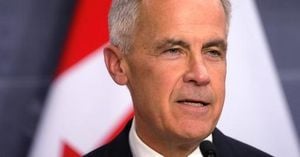At the crossroads of tradition and transformation, Mexico’s energy and mobility sectors are undergoing seismic changes. On August 15, 2025, industry leaders, policymakers, and innovators gathered at the Movilidad del Futuro forum, organized by 3M, to chart a path toward sustainable and efficient mobility. Meanwhile, on the broader energy front, the state-owned oil giant Pemex and emerging private players like Element Fuels are reshaping Mexico’s refining sector, each with their own ambitions and challenges. The convergence of these developments signals a pivotal moment for the country’s infrastructure, economy, and environmental future.
At the Movilidad del Futuro event, the consensus was clear: Mexico’s current infrastructure lags behind the demands of a modern, sustainable transport system. Julio Muñoz, Latin America Director for Transportation and Electronics at 3M, did not mince words. “There is a significant gap between existing infrastructure and what would be needed for widespread electric or hybrid vehicle adoption. The key is the user. They will decide which technology to adopt, but they must see both the ecological and economic benefits. Who would not want to switch if it is more efficient and saves money?” he told attendees, according to Mexico Business News.
Despite Mexico’s impressive standing as a leader in electric vehicle manufacturing, the reality on the streets paints a different picture. Over 90% of vehicles currently in circulation still rely on internal combustion engines. The reason? A lack of incentives and the slow pace of infrastructure upgrades. Yet, 3M remains undeterred. With a workforce of over 5,000 engineers, the company is actively developing tailored solutions for automakers. “Automakers often come to us with a specific problem, and we either adapt our existing technologies or develop new ones,” Muñoz explained, highlighting the company’s problem-solving ethos.
Innovation, however, is not just about grand gestures or sweeping reforms. Aaron Flores, a 3M automotive engineering expert, emphasized the importance of daily, practical advancements. “We work on horizontal and vertical signage with advanced retroreflectivity, visible even in rain,” Flores stated, underscoring how incremental improvements in materials and safety technologies can have an outsized impact on road safety and efficiency. 3M’s commitment to carbon neutrality by 2050, with a focus on durable, recyclable, and efficient materials, further cements its role as a driver of sustainable change.
But technology alone cannot solve the mobility puzzle. Claudia Salas, federal deputy and president of the Metropolitan Zones Commission, highlighted the challenges of urban planning and policy. With 70% of Mexico’s population residing in metropolitan areas, the breakdown of daily commutes is telling: 55% use public transport, 29% walk or cycle, and only 16% drive. “We still think in binary cities, focused on cars and public transport,” Salas remarked, calling for integrated systems that allow for seamless transitions between different modes of travel. The message was clear: Mexico’s cities must evolve beyond outdated, car-centric models.
Freight congestion adds another layer of complexity. Gabriel Padilla, Director General of the National Auto Parts Industry, noted that about 80% of automotive production moves via road, creating near-daily gridlock. “We must ease pressure on the road network and integrate rail, road, and ports,” Padilla argued. This sentiment was echoed by Francisco Fabila, President of the Mexican Railway Association, who pointed out that Mexico’s 23,000 kilometers of railways already transport 137 million tons of cargo and 51 million passengers annually. The solution, it seems, lies in better integration and smarter logistics.
Parallel to these mobility discussions, Mexico’s refining sector is experiencing its own wave of transformation. According to AInvest, Pemex’s 2025–2030 Work Plan is a bold attempt to reassert the nation’s energy sovereignty. The plan aims to boost oil production to 1.8 million barrels per day by 2030, relying on aggressive exploration—269 exploratory wells and 38,000 square kilometers of seismic studies are on the agenda. Perhaps most notably, the government has reversed its stance on fracking, lifting the ban to access unconventional resources. This policy shift is expected to help offset declining output from aging fields like Cantarell and reduce reliance on crude oil exports, which are projected to fall from 487,900 barrels per day in 2026 to 393,100 barrels per day by 2035.
Financially, Pemex is banking on a $13 billion funding injection in 2025, utilizing Participating Capital Instruments through a Luxembourg-based Special Purpose Vehicle. The goal: to insulate the government from direct liabilities and ensure liquidity for expansion. While Pemex’s debt is expected to decrease from $99 billion to $77.3 billion by 2030, operational efficiency and political will remain crucial. The company’s history of labor inefficiencies and bureaucratic inertia has some analysts questioning whether these ambitious targets are truly within reach.
Yet, Pemex is no longer the only player in town. Private-sector entrants like Element Fuels are introducing disruptive innovation and new business models. Element Fuels’ $1.2 billion Brownsville refinery, set to begin operations in 2027, will produce low-carbon gasoline, diesel, and jet fuel using hydrogen-powered processes. The facility’s location in the Port of Brownsville—a Free Trade Zone and the only deepwater seaport on the U.S.-Mexico border—gives it a strategic edge. Not only will it generate 100 megawatts of low-carbon electricity for the ERCOT grid, but it will also process 55,000 barrels of naphtha daily. The project is expected to create 2,000 construction jobs and 300 permanent roles, injecting much-needed economic vitality into the region.
Element Fuels’ approach aligns with Mexico’s ambitious goal of sourcing 45% of its energy from renewables by 2030. For investors, the company represents a compelling case study in private-sector-led energy transition. However, risks abound. Regulatory shifts, such as the 2025 energy reforms that favor state control, could limit private participation. Cartel-driven instability, including fuel theft (known locally as huachicol), and the dissolution of independent regulatory bodies like the Energy Regulatory Commission further complicate the landscape. As AInvest notes, “For investors, the key lies in diversification and alignment with Mexico’s long-term energy goals.”
The interplay between Pemex’s state-backed initiatives and private innovation presents a complex but potentially rewarding investment environment. Pemex’s scale and government support offer a degree of stability, especially in flagship projects like the Maya Refinery that aim to reduce dependence on imported fuels. Meanwhile, agile private players like Element Fuels fill gaps in Mexico’s aging infrastructure and bring cutting-edge technology to the table. Still, both sides face significant hurdles—whether it’s balancing debt and production for Pemex, or navigating regulatory and security risks for private firms.
In the final analysis, Mexico’s journey toward sustainable mobility and energy independence will depend on a delicate balance of state ambition and private-sector dynamism. The stakes are high, but so too are the rewards for those who can navigate this evolving landscape with clear eyes and steady hands.




